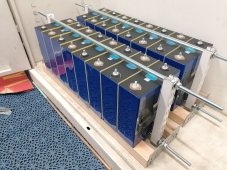So a one year (or 202 "cycles" since going live late last January, according to the BMS) follow up, should anyone else who has numptastically overcompressed their batteries Google this thread.
Obviously, YMMV, take this with a pinch of salt and apply your own judgement and reasoning; there's a lot of energy stored in these things.
Six bolts clamped back up to finger-tight (call it 1Nm). When the system went live I monitored them neurotically for the first few weeks while getting the system working generally, and didn't have any issues with the batteries. Lots of other problems to sort out with the inverter in the first month or so, resulting in a number early hours of the morning, head scratching at fault codes, in underpants, in a freezing cold loft moments; but never any hassle from the batteries.
This is how they're doing today after pulling about 70% out of them - 0.152V differential. They charge overnight at 56V/50A with the 150A BMS doing as much active load balancing as it can (from memory this is only an amp or two, from the highest voltage cell to the lowest during charging).
Curiously, there's no longer any sign of deformation ?.



